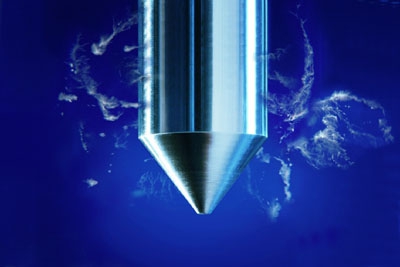
The new SONOPOWER DIGITAL 3S is Weber Ultrasonics' response to stricter requirements in the field of surface technology in terms of both process stability and profitability. The 3 kW ultrasonic generator has a whole host of innovative features and a control system based on a 32-bit processor architecture that lends it intelligence. This intelligence enables it to automatically make numerous settings, which in turn provides greater stability and reliability, while maintaining maximum performance and efficiency. The device is supplied ready-to-connect and is available with the frequencies 25 kHz and 40 kHz.
Efficient and stable processes that guarantee consistent results are a key prerequisite for profitability and competitiveness in the fields of industrial component cleaning and electroplating. Weber Ultrasonics has reacted to these requirements and designed the all-new SONOPOWER DIGITAL 3S. The 3 kW ultrasonic generator is equipped with various innovative features. It is controlled via a modern 32-bit processor architecture, similar to the kind used in smartphones. The SONOPOWER DIGITAL 3S is fully digital and excels through its exemplary ease-of-use. Even under difficult operating conditions, it secures maximum process stability and performance. Employing the frequencies of 25 kHz and 40 kHz, which are frequently used in the fields of component cleaning and electroplating, it is suitable for a broad range of applications.
Thanks to the new Weber SONOSCAN, the generator automatically determines and sets its operating frequency. This is already performed before any ultrasonic output and thus increases the process reliability for cleaning and electroplating applications. The continuous monitoring and automatic adjustment of the frequency also ensures that the system always uses the optimum output, even when operating conditions change, for example, in the case of temperature fluctuations, when switching over from cleaning to rinsing medium, or when replacing a transducer. Thanks to this new technology, the generator also detects whether a transducer system is connected at all. This prevents damage to the generator due to "dry running."
Of course, conventional generators are also capable of detecting when they get too hot. However, they then simply switch off, which leads to an interruption in the process and requires manual intervention. The new SONOPOWER DIGITAL 3S is quite different in this regard, as it independently adapts its fan speed in accordance with the prevailing situation. The parts can then continue to be treated with no loss of performance/quality and without the generator overheating.
In addition to this, the SONOPOWER DIGITAL 3S is capable of independently detecting the mains voltage and then adapting to this and not only during installation. It continuously measures the mains voltage and reacts promptly to any overvoltage or undervoltage, as well as to voltage fluctuations. This also contributes to consistent quality of the cleaning or electroplating process.
On the SONOPOWER DIGITAL 3S, the sweep function and the power output can each be individually adjusted in 1 percent steps, allowing users to set up various modes exactly as they wish and integrate these into parts-specific treatment programmes. This in turn allows easy adjustment of the ultrasonic treatment to various or varying ranges of parts. At the same time, the new 32-bit processor architecture makes it possible to further extend the intelligence of the generator, thereby offering flexibility for resolving future tasks.
The new power section of the SONOPOWER DIGITAL 3S also makes a valuable contribution in this regard, as its output stage is twice as powerful as those used in previous generators. This offers high power reserves for greater safety and reliability, in particular when handling tasks for which previous generators were forced to operate at their limits. Not least thanks to Weber SONOSCAN, it is also more tolerant with regard to transducer systems and supply lines. As such, the generator reacts less critically to differences in transducer systems caused by material tolerances, ageing or wear.
Another plus point of the new 3 kW generator is its IEC-compliant PLC interface. This makes it fully compatible with the programmable logic controllers (PLCs) typically used in the field of automation. The optimum communication between the generator and the PLC that results from this not only simplifies commissioning, but also any potential troubleshooting.






